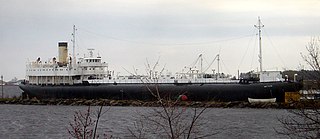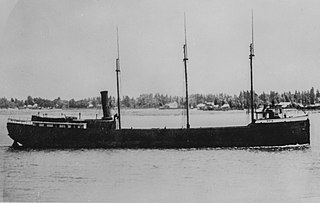
Lake freighters, or lakers, are bulk carrier vessels that operate on the Great Lakes of North America. These vessels are traditionally called boats, although classified as ships.

SSMeteor is the sole surviving ship of the unconventional "whaleback" design. The design, created by Scottish captain Alexander McDougall, enabled her to carry a maximum amount of cargo with a minimum of draft. Meteor was built in 1896 in Superior, Wisconsin, United States, and, with a number of modifications, sailed until 1969. She is now a museum ship in the city of her construction.

The SS Regina was a cargo ship built for the Merchant Mutual Line and home ported in Montreal, Quebec. Named after Regina, Saskatchewan, Regina had a tonnage of 1,956 gross register tons (GRT) and a crew of 32.

The Sagamore is reported to be the best example of a whaleback barge among Great Lakes shipwrecks. Only 44 whalebacks were ever built, and out of the 26 that sank, only 8 sank in the Great Lakes, most of them being blown up for blocking shipping channels. She sank in 1901 in the shipping lane near the Soo Locks when she was rammed by the steel steamer Northern Queen in one of Whitefish Bay's notorious fogs. Her captain and two crew members went down with her. Artifacts from her wreck were illegally removed in the 1980s. Her artifacts are now the property of the State of Michigan and are on display as a loan to the Great Lakes Shipwreck Museum. The wreck of the Sagamore is protected as part of an underwater museum in the Whitefish Point Underwater Preserve.

The SS M.M. Drake was a wooden steam barge that towed consorts loaded with coal and iron ore on the Great Lakes. She came to the rescue of the crews of at least 4 foundering vessels in her 19 year career only to meet the same fate in her final rescue attempt. Drake sank in 1901 off Vermilion Point after a rescue attempt of her consort Michigan. Her rudder, anchor, and windlass were illegally removed from her wreck site in the 1980s. They are now the property of the State of Michigan. The rudder is on display as a loan to the Great Lakes Shipwreck Museum and the anchor and windlass are on loan for display to Whitefish Township Community Center. The wreck of Drake is protected as part of an underwater museum in the Whitefish Point Underwater Preserve.
The Besser Museum for Northeast Michigan is a community museum serving Alpena County and surrounding counties in the U.S. state of Michigan. Alpena is a port city on Lake Huron. The museum defines its role broadly — to preserve, protect and present history and culture closely connected with the heritage of Northern Michigan and the Great Lakes. The museum includes a small publicly-owned planetarium.

The Norman was a bulk freighter; its wreck in Lake Huron was listed on the National Register of Historic Places in 2016.

The Kyle Spangler was a wooden schooner; its 1860 wreck site in Lake Huron was listed on the National Register of Historic Places in 2016.
Minnedosa was a four-masted wooden Great Lakes schooner launched in 1890. This was late in the era of sailing ships and it spent its career as a barge, towed by a steam tug. It was lost with its nine crew and passengers and a heavy load of grain in a storm October 20, 1905 on Lake Huron.

SS D.R. Hanna was a 552-foot (168 m) long American Great Lakes freighter that operated on the Great Lakes from November 12, 1906 to her sinking on May 16, 1919 after a collision with Quincy A. Shaw. D.R. Hanna was like many other freighters, and was used to haul bulk cargoes such as iron ore, coal and grain.

SS Choctaw was a steel-hulled American freighter in service between 1892 and 1915, on the Great Lakes of North America. She was a so-called monitor vessel, containing elements of traditional lake freighters and the whaleback ships designed by Alexander McDougall. Choctaw was built in 1892 by the Cleveland Shipbuilding Company in Cleveland, Ohio, and was originally owned by the Lake Superior Iron Company. She was sold to the Cleveland-Cliffs Iron Company in 1894 and spent the rest of her working life with it. On her regular route between Detroit, Escanaba, Marquette, and Cleveland, she carried iron ore downbound, and coal upbound.

SS Ohio was a wooden hulled Great Lakes freighter that served on the Great Lakes of North America from her construction in 1875, to her sinking in September 1894 when she collided with the schooner barge Ironton which also sank in the collision. Ironton was being towed by the steamer Charles J. Kershaw, which was also towing the schooner Moonlight. Ohio was found upright in 2017, over 122 years after her sinking in over 200 feet of water off Presque Isle, Michigan. Ironton is still missing. The researchers who discovered Ohio plan to nominate her for a listing in the National Register of Historic Places.

SS Etruria was a steel hulled lake freighter that served on the Great Lakes of North America from her construction in 1902 to her sinking in 1905. On June 18, 1905, while sailing upbound on Lake Huron with a cargo of coal, she was rammed and sunk by the freighter Amasa Stone 10 miles (16 km) off Presque Isle Light. For nearly 106 years the location of Etruria's wreck remained unknown, until the spring of 2011 when her wreck was found upside down in 310 feet (94 m) of water.

SS Russia was an iron-hulled American Great Lakes package freighter that sank in a Lake Huron gale on April 30, 1909, near DeTour Village, Michigan, with all 22 of her crew and one passenger surviving.

SS John Mitchell was a steel-hulled, American lake freighter in service between 1907 and 1911. She was built in 1906 by the Great Lakes Engineering Works in St. Clair, Michigan, for the Cornell Steamship Company of Chicago, Illinois, which was managed by C.W. Elphicke. She entered service in 1907, and had a sister ship named William B. Davock. Throughout her career, John Mitchell carried iron ore and coal. On October 4, 1908, she ran aground at Indiana Harbor, Indiana, while loaded with iron ore.

SS Chester A. Congdon was a steel-hulled American lake freighter in service between 1907 and 1918. She was built in 1907 by the Chicago Shipbuilding Company of South Chicago, Illinois, for the Holmes Steamship Company, and was intended to be used in the grain trade on the Great Lakes. She entered service on September 19, 1907, when she made her maiden voyage. In 1911, Salt Lake City was sold to the Acme Transit Company. A year later, she was transferred to the Continental Steamship Company, and was renamed Chester A. Congdon, after lawyer and entrepreneur Chester Adgate Congdon. She was involved in several accidents throughout her career.

















